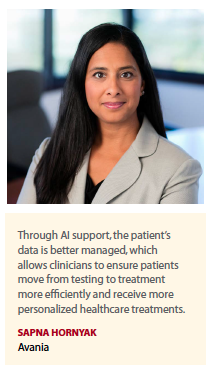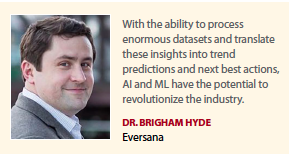AI and machine learning have the potential to transform the life-sciences industry, but barriers around implementation, process, and regulatory uncertainty must be overcome first.
Artificial intelligence and machine learning are very much part of the pharmaceutical landscape today and are expected to play an even bigger role in the future. Whether in drug discovery, clinical trials, regulatory activities, manufacturing, or commercial, AI and ML are increasingly seen as transformative technologies for the industry. Reports estimate that the market for AI in drug discovery alone will reach $6.6 billion by 2021, while a study of healthcare executives found more than 50% expect wide AI adoption across the industry by 2025.
 PharmaVOICE has been keeping a close eye on AI for several years, each month publishing news about AI developments, technologies, and breakthroughs. There is never a shortage of new information, further underscoring the growth in the market and the huge potential for AI across all aspects of healthcare. Indeed, increased industry competition means companies depend on good market insights to make R&D decisions, drive strategies, and quickly respond to developments.
PharmaVOICE has been keeping a close eye on AI for several years, each month publishing news about AI developments, technologies, and breakthroughs. There is never a shortage of new information, further underscoring the growth in the market and the huge potential for AI across all aspects of healthcare. Indeed, increased industry competition means companies depend on good market insights to make R&D decisions, drive strategies, and quickly respond to developments.
“The application of AI and ML models has been, and will continue to be, transformative in enhancing the quality of automation and informing key business decisions," says Brigham Hyde, Ph.D., president, data and analytics, Eversana.
From Research to the Clinic
According to Jonathan Burr, senior VP, clinical platform strategy, Saama Technologies, most life-science R&D efforts are using AI in some shape or form, with attention on AI capabilities accelerating since the COVID-19 pandemic. In terms of advanced R&D, AI will be critical to support quantum, or next-generation, computing technology that is being developed to facilitate in silico research for high-throughput drug screening, he says.
He adds that state-of-the-art automation platforms infused with natural language understanding and ML are informing real-time transactional systems for drug R&D.
Some organizations have AI deeply entrenched within all practices. According to Lucas Glass, global head, Analytics Center of Excellence, IQVIA, AI is being used throughout the company. “On the R&D side, there are administrative efficiency applications such as clinical AI translations, intelligent eTMF, protocol  digitization, and medical writing automation," he says. “Project leads are building virtual assistants, project finance/resource and risk predictions, and enrollment coaching networks. In trial strategy, we are using AI to recommend countries and sites and accurately predict study timelines. Patient recruitment is rich with AI. We are deploying AI at sites to read EMR data and find undiagnosed patients that are otherwise challenging to identify. We are optimizing our patient outreach targeting. We have chatbots for trial matching.
digitization, and medical writing automation," he says. “Project leads are building virtual assistants, project finance/resource and risk predictions, and enrollment coaching networks. In trial strategy, we are using AI to recommend countries and sites and accurately predict study timelines. Patient recruitment is rich with AI. We are deploying AI at sites to read EMR data and find undiagnosed patients that are otherwise challenging to identify. We are optimizing our patient outreach targeting. We have chatbots for trial matching.
We are predicting participant dropout. And further upstream in R&D we are predicting clinical trial outcomes, drug protein interactions, repurposing drugs, and even leveraging AI to optimize molecules."
According to Prakriteswar Santikary, Ph.D., VP, global chief data officer, ERT, AI has the potential to disrupt every stage of the clinical trial process, with applications ranging from matching eligible patients to studies, monitoring drug adherence, improving patient recruitment and retention, to enhancing data collection, risk monitoring, and patient compliance. “This has the potential to improve trial quality, reduce trial times, and dramatically shorten the time to market of lifesaving drugs and therapies, delivering a huge win for patients and pharmaceutical developers," Dr. Santikary says.
 One of the ways that AI is being used in a clinical setting today is for more efficient review and analysis of vast amounts of clinical data with fewer human errors, says Sapna Hornyak, president and CEO of Avania. She adds that AI enables patients’ data to be better managed, which allows clinicians to ensure patients move from testing to treatment more efficiently and receive more personalized healthcare treatments. “This application benefits all stakeholders, including clinicians, patients, and health systems," she says. “A more specific application in clinical trials is in the patient recruitment process where AI is applied to patient screening to improve early detection and identification of conditions. AI supports the whole continuum — from diagnostic, e.g., imaging, to surgical support, e.g., robotics, by aiding in procedures."
One of the ways that AI is being used in a clinical setting today is for more efficient review and analysis of vast amounts of clinical data with fewer human errors, says Sapna Hornyak, president and CEO of Avania. She adds that AI enables patients’ data to be better managed, which allows clinicians to ensure patients move from testing to treatment more efficiently and receive more personalized healthcare treatments. “This application benefits all stakeholders, including clinicians, patients, and health systems," she says. “A more specific application in clinical trials is in the patient recruitment process where AI is applied to patient screening to improve early detection and identification of conditions. AI supports the whole continuum — from diagnostic, e.g., imaging, to surgical support, e.g., robotics, by aiding in procedures."
According to Mr. Burr, smart applications facilitate the ingestion and mapping of study-specific raw clinical data into industry-specific standards, as well as predicting data discrepancies and accelerating the complex work of clinical data managers to ensure that clinical data is locked in time for analysis.
 Furthermore, AI-powered chatbots are facilitating unprecedented conversational experiences with clinical trial data to help researchers overcome obstacles historically associated with development and assist in the delivery of safe and effective therapies, Mr. Burr says.
Furthermore, AI-powered chatbots are facilitating unprecedented conversational experiences with clinical trial data to help researchers overcome obstacles historically associated with development and assist in the delivery of safe and effective therapies, Mr. Burr says.
AI also has been instrumental in driving faster drug repurposing and repositioning to treat patients with COVID-19 since it can help to reduce development timelines. A recent Lancet article states AI allows researchers to apply information science to defining disease, medicine, therapeutics, and identifying targets with reduced errors. AI also supports more rapid detection and treatment of patients, Mr. Burr says. “At the University of Oxford, infectious disease and clinical machine learning experts have developed a test that can rapidly screen for COVID-19 in patients arriving in emergency departments," he says. “The test uses AI to give a near real-time prediction of a patient’s COVID-19 status."
Another area where AI is being used is in rare diseases to help accelerate accuracy and speed of diagnosis, Dr. Hyde says.“By leveraging real-world data and applying ML algorithms to large healthcare data sets, we’re able to shorten the time to diagnoses and even discover undiagnosed rare disease patients residing in large national healthcare databases," he says. “Predictive modeling can glean insights from hundreds of millions of datasets, allowing therapies to proactively find patients rather than patients needing to seek out therapies."
AI Into the Future
Understanding AI’s potential requires knowing its capabilities and limitations as well as overcoming some of the bifurcation that data science and technology have in our industry, Mr. Glass says. “AI can synthesize huge amounts of data to put the right information in front of the right person at the right time to make the right decision," he says. “AI will guide us toward which molecules to progress, which indications to pursue, which study designs to select, which country to run those studies in, which sites to activate, which sites to monitor, which physician to detail, which therapies and trials to present to an undertreated patient, and more."
The potential for AI application is extensive, experts believe. According to Mr. Burr, while it is currently possible to run AI algorithms on a digital representation of a human organ to assess drug impact, in the not-too-distant future it will be possible to use AI to create a digital twin of the entire human body to simultaneously assess the impact of a prospective drug on multiple organs. “This will be a game changer in how trials are conducted," he says.
“Imagine a world where a machine could conduct the equivalent of Phase I, II and III research, with a high degree of accuracy and without having to subject humans to experimental therapies. Having been proven through AI to be safe and effective in silico, a drug could potentially be brought to market for qualified patient engagement with a label indicating a real-world testing phase."
Breaking Down AI Barriers
While uptake of AI capabilities is gathering momentum in the industry, healthcare has been slower to embrace its potential than many other industries. Regulatory concerns have been a barrier, as has reticence due to previous large technology investments that have failed to significantly improve R&D.
Making AI both impactful and scalable can be more difficult than companies realize and requires a solid foundation first, says Derek Choy, president at Aktana. “We sometimes see companies use ML to build predictive next-best-action models," he says. “They typically invest a lot of time and effort preparing the data and refining the model, but they don’t give enough consideration to how they should deploy the output of those models to users in the field or other channels."
He adds that if the process for developing, refreshing, producing, and integrating new models into the workflow is not scalable, it won’t be long before their outputs are out of date. This can be remedied by building analytics and ML models on the same dataset, making sure to use the same factors and considerations that will be used in deployment. Pairing business rules with ML models is another way to drive adoption. By clarifying when certain triggers should take priority or prevent redundant contact, business rules function as constraints to ensure AI-generated recommendations make sense in the real world.
 “It is also essential to put mechanisms in place for ongoing optimization," Mr. Choy says. “Every piece of feedback, collected directly from the user or surmised from a customer’s response, should be leveraged to hone recommendations, and build user confidence over time. When these foundational elements are given thoughtful consideration from day one, greater AI adoption will naturally follow."
“It is also essential to put mechanisms in place for ongoing optimization," Mr. Choy says. “Every piece of feedback, collected directly from the user or surmised from a customer’s response, should be leveraged to hone recommendations, and build user confidence over time. When these foundational elements are given thoughtful consideration from day one, greater AI adoption will naturally follow."
Other issues holding back broader adoption of AI include discomfort with changing traditional processes and fear that AI will replace human beings. Mr. Barr says fundamental change is needed.
“We must rethink the models of how we run clinical trials, reassess our current computing power, revisit regulatory approval processes, and improve the ability of regulators to have direct, real-time access to trial data," he says. “We also need to alter the popular perception of AI, so people understand that AI is not being leveraged with the intention of replacing humans, but instead augmenting what humans are capable of."
Mr. Glass says the quality of technology and an understanding of decision intelligence need to change to drive greater adoption. “All too often our industry has AI algorithms that are several steps removed from the person for whom the information or recommendation is needed," he says. “A data scientist will train an algorithm and build a report, that report then goes to someone who in turn sends it to another person. This creates uncertainty as to whether the algorithm made any difference in our business or whether anyone was listening."
“The second area of challenge is with decision intelligence — we need a systematic approach to choosing the correct use cases through user research, which helps identify decision points and behavior where AI can provide a boost while being cognizant of user biases and psychology," he says. “Right now, we assume that if we build an accurate algorithm, people will listen and it will optimize our business. But that is not always the case. We need to carefully study  the psychology of our experts’ decision-making processes and embed AI into those decision-making processes in a manner that is synergistic rather than antagonistic."
the psychology of our experts’ decision-making processes and embed AI into those decision-making processes in a manner that is synergistic rather than antagonistic."
Dr. Hyde says AI and ML could revolutionize the industry by processing enormous datasets and translating insights into trial trend predictions and next best actions. “Just about any product or service can be enhanced with ML algorithms analyzing data, searching for patterns, and making automated decisions," he says. “The challenge is that change continues to accelerate. The trajectory of our progress is not based on where we’ve been or the current rate today; the trajectory builds on new technology, and it is ever increasing. Skipping or avoiding phases of technology change can quickly hinder businesses, making it imperative to constantly assess and adapt to technology solutions."
As Mr. Burr points out, AI is fundamentally a continuation of cognition and, while the creation of a cognitive-capable machine is not yet available, there are ongoing efforts to achieve this goal. “If we adapt our traditional processes, thinking, and expectations we will achieve greater adoption of AI and ensure the betterment of human health," he says.(PV)
~~~~~~~~~~~~~~~~~~~~~~~~~
AI in Clinical Trials
AI is increasingly being used in different aspects of the clinical process, including:
Intelligent Clinical Trials: AI-driven protocol designs powered by algorithms and deep learning techniques can reduce trial complexities by analyzing operational data from historical cases, measuring responses to drugs, and predicting site performance.
Patient Recruitment and Retention: By extracting pertinent information from EMR and EHR systems, sifting through physicians’ notes, reading binary data from images and comparing them with the requirements of ongoing clinical trials, AI can accelerate patient recruitment and improve retention throughout the lifecycle of clinical trials.
Optimizing Virtual Trials: Using AI-assisted chatbots and voicebots, patients can participate in virtual trials without having to visit the sites. Also, custom-built algorithms can enable the recruitment of untapped patient populations via targeted social media, thereby qualifying high-potential subjects who would otherwise be ignored.
Source: Prakriteswar Santikary, Ph.D., ERT











